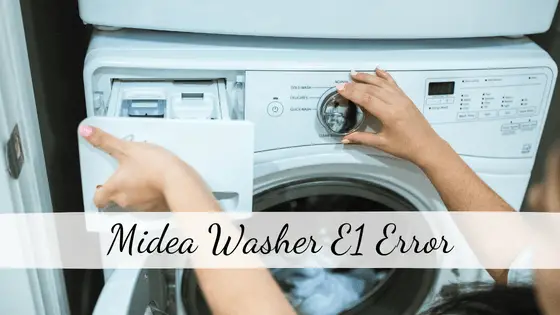Have you ever been in the middle of doing your laundry only to be interrupted by an error message on your Midea washer?
Have you ever encountered an error message on your Midea washer and wondered what it means?
One common error that Midea washer users may encounter is the E1 error.
The Midea washer E1 error often indicates a problem with the water supply system which is preventing the machine from functioning properly.
In this article, we’ll explore the various causes of the E1 error and provide potential solutions for fixing it in detail.
Midea Washer E1 Error- Meaning
E1 is an error code that can appear on certain models of Midea washing machines.
It typically indicates a problem with the water supply system, which is preventing the machine from functioning properly.
Possible causes of the E1 error include a blocked or restricted water inlet hose, a faulty water inlet valve, or an issue with the water supply itself.
To troubleshoot the problem, you can check the water inlet hose, water inlet valve, and water supply.
If these steps do not resolve the issue, you may need to call a repair technician to diagnose and fix the problem.
It is important to refer to the owner’s manual for specific troubleshooting steps for your model of Midea washing machine.
Midea Washer E1 Error- Causes
There are several potential causes of the Midea washer E1 error.
Some common causes include:
Blocked or restricted water inlet hose
The water inlet hose is a crucial component of a washing machine, as it is responsible for supplying water to the machine.
It is typically located at the back of the machine and connects to a water supply line.
If the water inlet hose becomes blocked or restricted, it can prevent the washing machine from filling with water properly, resulting in the E1 error.
Faulty water inlet valve
The water inlet valve is another important component of a washing machine, as it is responsible for controlling the flow of water into the machine.
If the water inlet valve becomes faulty or damaged, it can prevent the washing machine from filling with water properly, resulting in the E1 error.
Low water pressure
If the water pressure in the home is too low, it can prevent the washing machine from filling with water properly, resulting in the E1 error.
Water pressure is the force at which water is delivered through the pipes in a home, and it is measured in pounds per square inch (psi).
Most washing machines require a minimum water pressure of at least 20 psi to function properly.
If the water pressure in the home is lower than this, it can cause the washing machine to fill slowly or not fill at all, resulting in the E1 error.
Shut-off valve not fully open
If the shut-off valve that controls the water supply to the washing machine is not fully open, it can restrict the flow of water to the machine, causing the E1 error.
The shut-off valve is typically located near the water supply line that connects to the washing machine, and it is responsible for controlling the flow of water to the machine.
If the shut-off valve is not fully open, it can restrict the flow of water to the machine, causing the E1 error.
Faulty water supply system
If there is a problem with the home’s water supply system, it can cause the E1 error to appear on the washing machine.
The water supply system is responsible for delivering water to the home, and it includes a variety of components such as the water main, the water meter, and the pipes that deliver water to the different areas of the home.
If any of these components is faulty or malfunctioning, it can cause the E1 error to appear on the washing machine.
Midea Washer E1 Error- Fixes
Here are ways to fix the above causes of Midea Washer E1 Error:
Fix a blocked or restricted water inlet hose
To fix a blocked or restricted water inlet hose, you can try the following steps:
- Locate the water inlet hose at the back of the washing machine.
- Check the hose for any visible kinks or bends. If you find any, straighten the hose to eliminate the kink.
- Check the hose for any visible blockages or debris. If you find any, remove the blockage or debris to clear the hose.
- If the hose appears to be in good condition and there are no visible blockages or kinks, try flushing the hose with water to remove any accumulated sediment or debris.
- If these steps do not resolve the issue, it is possible that the water inlet hose may be damaged and will need to be replaced.
Fix a faulty water inlet valve
- Locate the water inlet valve at the back of the washing machine.
- Check the valve for any visible damage or corrosion. If you find any, the valve may need to be replaced.
- Check the valve for proper operation. If the valve is not functioning properly, it may need to be replaced or repaired.
Fixing a low water pressure
- Check the water pressure in the home using a pressure gauge. You can purchase a pressure gauge at a hardware store or online.
- Compare the water pressure reading to the recommended levels for your washing machine. Most washing machines require a minimum water pressure of at least 20 psi to function properly.
- If the water pressure is lower than the recommended levels, you can try the following steps to increase the water pressure:
- Check for leaks in the home’s water supply line. A leak can cause the water pressure to drop, so fixing any leaks can help improve the water pressure.
- Check the home’s water pump and pressure regulator. If either of these components is faulty or malfunctioning, it can cause the water pressure to drop.
- Check the home’s water meter and water main. If there is a problem with either of these components, it can cause the water pressure to drop.
Fix a shut-off valve that is not fully open
- Locate the shut-off valve near the water supply line that connects to the washing machine.
- Check the valve to ensure it is fully open. If it is not fully open, turn the valve clockwise to open it fully.
- If the valve is already fully open, check for any visible damage or corrosion. If you find any, the valve may need to be replaced.
Fixing a faulty water supply system
1.Check for leaks or blockages in the home’s water supply line.
If you suspect that there is a leak or blockage in the water supply line, you can try shutting off the water supply to the home and inspecting the pipes for any visible signs of damage or leaks.
If you find any, you may need to call a plumber to fix the problem.
2. Check the home’s water meter and water pump.
If either of these components is faulty or malfunctioning, it can cause the E1 error to appear on the washing machine.
You may need to call a plumber to diagnose and fix the problem.
3. Check the home’s water main for any visible signs of damage or corrosion.
If you find any, you may need to call a plumber to fix the problem.
How to Reset Midea Washer?
If you’ve tried the above fixes and are still experiencing the Midea washer E1 error, you may need to reset the washer.
To reset your Midea washer, follow these steps:
- Unplug the washer from the electrical outlet. This will cut power to the appliance and allow you to safely reset it.
- Wait for a few minutes. This will give the washer’s internal components time to cool down and reset.
- Plug the washer back in and press the power button for 5 seconds. This will turn the washer back on and reset its internal system.
- Attempt to start a wash cycle again. If the reset was successful, the washer should start a wash cycle without displaying the E1 error message.
If resetting the washer does not fix the E1 error, you may need to seek professional help from a Midea authorized service center.
It is also a good idea to check the user manual for your specific model of Midea washer, as it may have specific instructions on how to troubleshoot and fix errors.
Note: It is important to follow all safety precautions when working on or troubleshooting your Midea washer.
If you are unsure of how to properly diagnose or fix the issue, it is recommended to seek help from a professional.
Sources:
https://www.midea.com/us/customer-support/manuals
Related Articles:

